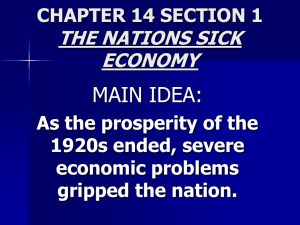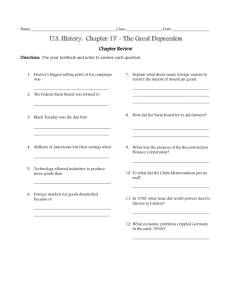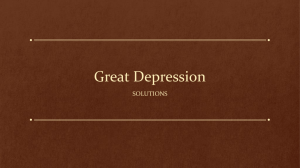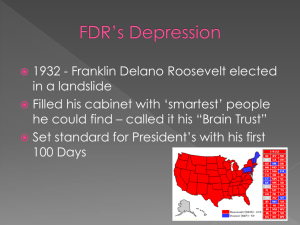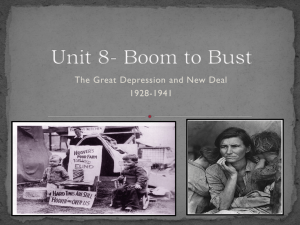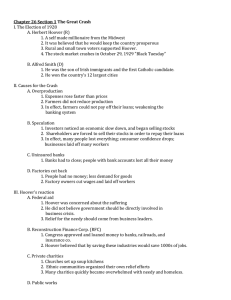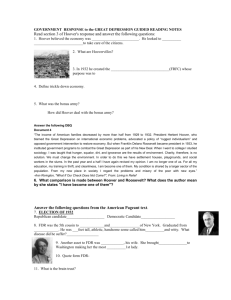Causes of the Great Depression
advertisement
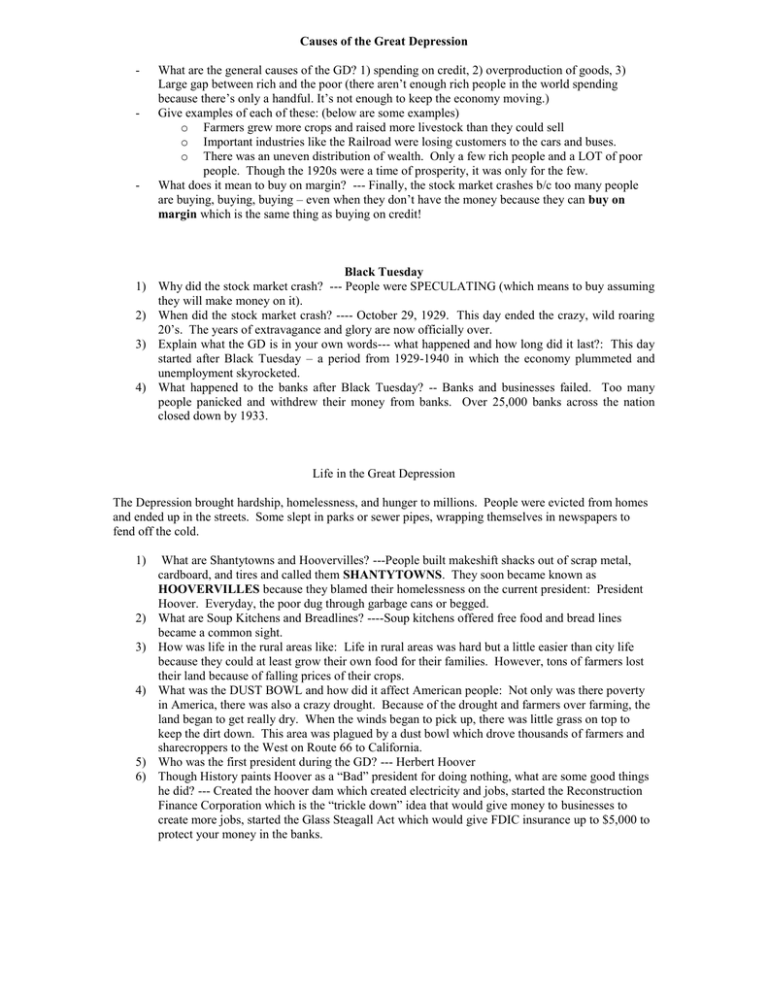
Causes of the Great Depression - - - What are the general causes of the GD? 1) spending on credit, 2) overproduction of goods, 3) Large gap between rich and the poor (there aren’t enough rich people in the world spending because there’s only a handful. It’s not enough to keep the economy moving.) Give examples of each of these: (below are some examples) o Farmers grew more crops and raised more livestock than they could sell o Important industries like the Railroad were losing customers to the cars and buses. o There was an uneven distribution of wealth. Only a few rich people and a LOT of poor people. Though the 1920s were a time of prosperity, it was only for the few. What does it mean to buy on margin? --- Finally, the stock market crashes b/c too many people are buying, buying, buying – even when they don’t have the money because they can buy on margin which is the same thing as buying on credit! Black Tuesday 1) Why did the stock market crash? --- People were SPECULATING (which means to buy assuming they will make money on it). 2) When did the stock market crash? ---- October 29, 1929. This day ended the crazy, wild roaring 20’s. The years of extravagance and glory are now officially over. 3) Explain what the GD is in your own words--- what happened and how long did it last?: This day started after Black Tuesday – a period from 1929-1940 in which the economy plummeted and unemployment skyrocketed. 4) What happened to the banks after Black Tuesday? -- Banks and businesses failed. Too many people panicked and withdrew their money from banks. Over 25,000 banks across the nation closed down by 1933. Life in the Great Depression The Depression brought hardship, homelessness, and hunger to millions. People were evicted from homes and ended up in the streets. Some slept in parks or sewer pipes, wrapping themselves in newspapers to fend off the cold. 1) 2) 3) 4) 5) 6) What are Shantytowns and Hoovervilles? ---People built makeshift shacks out of scrap metal, cardboard, and tires and called them SHANTYTOWNS. They soon became known as HOOVERVILLES because they blamed their homelessness on the current president: President Hoover. Everyday, the poor dug through garbage cans or begged. What are Soup Kitchens and Breadlines? ----Soup kitchens offered free food and bread lines became a common sight. How was life in the rural areas like: Life in rural areas was hard but a little easier than city life because they could at least grow their own food for their families. However, tons of farmers lost their land because of falling prices of their crops. What was the DUST BOWL and how did it affect American people: Not only was there poverty in America, there was also a crazy drought. Because of the drought and farmers over farming, the land began to get really dry. When the winds began to pick up, there was little grass on top to keep the dirt down. This area was plagued by a dust bowl which drove thousands of farmers and sharecroppers to the West on Route 66 to California. Who was the first president during the GD? --- Herbert Hoover Though History paints Hoover as a “Bad” president for doing nothing, what are some good things he did? --- Created the hoover dam which created electricity and jobs, started the Reconstruction Finance Corporation which is the “trickle down” idea that would give money to businesses to create more jobs, started the Glass Steagall Act which would give FDIC insurance up to $5,000 to protect your money in the banks. Social Effects on Men, Women, and Children 1) How did many families entertain themselves during the GD? ----When money was right, many families entertained themselves by staying at home and playing board games, such as Monopoly and listening to the radio. However, many families broke apart under the strain of the G.D. 2) How did the GD affect men? Give examples ---Men had an extremely difficult time coping with unemployment because they were used to supporting their families. More and more men wandered the country, hitching rides on railroad cars, and sleeping under bridges. Many stood in unemployment lines in search for a job for days, months, and years without any good news. Eventually, many left their families. 3) How did the GD affect women? ---Women worked hard to support their families. They worked outside the home and were paid less than men. Men hated seeing women work because it meant that they were stealing jobs. Many women were also begging on the streets or standing in bread lines to feed their children. 4) How did the GD affect children? ---All across America, children had poor diets and a lack of money for health care. They were eating violet tops, dandelions, and wild greens. Milk was hard to find and there was a rise in malnutrition. School sessions were shortened and thousands of kids went to work in sweatshops. 5) How did the GD affect teenagers? ---Many teenagers decided to find their adventures riding on the top of trains. Though this was extremely dangerous, it as either this or staying at home being “another mouth to feed.” Many teenagers ran away from home in order to escape the sadness of poverty. Herbert Hoover’s Philosophy vs. FDR’s PHilosophy 1) What are some key points about what Hoover believed in? a. He really did want to get his people out of their slump. However, he did not feel that giving handouts was the way to go. b. Believed that government should stay out of businesses’ life. They should succeed or fail on their own. c. He thought welfare was way too expensive and that it would create people who depend on the government to give them things rather than individual’s hard work. d. One thing he DID do that made a difference was the construction of the HOOVER DAM which provided jobs, electric power, and flood control to many people in the Colorado River Basin. We couldn’t have California’s massive farming industries today if it weren’t for this dam. This dam also provides water to Los Angeles and Las Vegas. e. Hoover did not give DIRECT RELIEF to the people. They were shocked and upset about this. He did approve the Reconstruction Finance Corporation (RFC) which gave money to banks, life insurance companies, railroads and other large businesses with the idea in mind that this money would trickle down to the average citizen through jobs and higher wages. 2) What are some key points that FDR believed in? a. Believed that the government needed to get involved in business. b. Direct Relief should be given straight to the poor people in the form of housing, money, and food c. Create jobs as fast as possible so that every American is back to work. d. Deficit spending --- to spend the money to create jobs even when America does not have it. The money will come eventually once the economy starts moving again. THE NEW DEAL 1) What is the Brain Trust? --- The Brain Trust: a team of carefully picked advisers – professors, lawyers, journalists – who helped FDR draft a set of plans for America and the G.D. 2) What is the New Deal? --- The programs that would help America heal from the G.D. is known as the NEW DEAL. 3) What are the problems of the Great Depression? --1) Massive Poverty – Hoovervilles, hooverblankets, banks closed down 2) Unequal Distribution of Wealth – 1% owned 59% of the wealth 3) Overproduction of Goods – farmers had way too much cotton, wheat, pigs. 4) High Unemployment: Over 25% 4) What is the Hundred Days: a period of intense activity which lasted about 3 months. FDR passes 15 laws and gave the federal government a huge role in the nation’s economy. Not a lot of people like it when the federal government takes charge. Many people find this “controlling” and “overbearing.” However, this is what needed to be done! 5) What is the Bank Holiday: Right when Roosevelt took office, he declared a bank holiday and closed all banks to prevent further withdrawals. He passed the Emergency Banking Relief Act which got the Treasury Department to inspect the country’s banks. If they were sound (ok), they could reopen. If they were unable to pay their debts, they had to remain closed till they could. Because of this, the public began to regain faith in placing their money into the banks. 6) What are Fireside Chats: radio talks about issues of public concern where the President would explain in clear, simple language his New Deal plans. These informal talks made Americans feel as if the President were talking directly to them. 7) What is the Glass-Steagall Act: made your bank FDIC for up to $5,000. Hoover actually created this but FDR brought it back. 8) What is AMENDMENT 21 repeals/cancels Prohibition (Amendment 17). Now alcohol can be sold but it will be taxed higher than regular items. NEW DEAL PROGRAMS Agricultural Adjustment Act (AAA): helped farmers raise crop prices. It also paid hog farmers to slaughter 6 million pigs. This upset a lot of people but it worked really well! Tennessee Valley Authority (TVA): this project remodeled five existing dams and constructed 60 new ones along the T.V. river which was an extremely POOR area. It gave jobs to thousands and provided flood control and cheap electricity for the poor who never got to have electricity in their homes. It gave unemployed farmers the chance to work by helping southern farmers with new techniques. Civilian Conservation Corp (CCC): Put young men age 18-25 to work building roads, developing parks, planting trees, etc. It paid small wages ($30 a month) but it was sent home to their families to supply food and other needs. This got everyone to do a small job just to get paid. Social Securities Act (SSA)– gave Age old insurance to the elderly and to kids of disabled parents Works Progress Administration (WPA) – gave small jobs to people so that every American could return back to work and feel some dignity and pride in their lives again. Public works administration (PWA) – got the money to build public schools, pay public school teachers, and build roads. Home Owners Loan Corporation (HOLC) – gave home owners who were about to be foreclosed on a loan. They won’t have to live in shanty towns or hoovervilles. FDR’s CRITICS Tons of opposition was against FDR and his New Deal. Everyone wanted to say that it was unconstitutional for the Federal Government to play such a large role. They said the AAA was a local matter and that the Feds should not get in the way. It’s another Federal vs. State argument which dates back to the foundations of our government with the Federalists vs. AntiFederalists. Three Critics were Charles Coughlin, Dr. Francis Townsend, and Huey Long. Father Charles Coughlin: a priest who felt that Roosevelt wasn’t doing enough. He had radio sermons and wanted a guaranteed annual income. Dr. Francis Townsend: a doctor from Long Beach, CA who said that Roosevelt wasn’t doing enough for the poor and the elderly. He created his own plans which he thought were better than Roosevelt’s. Huey Long: Senator of Louisiana who wanted to be President. He wanted something for everyone and called his program “SHARE-YOUR-WEALTH.” Harlem Renaissance Figures 1) Marcus Garvey – UNIA, Back to Africa Movement, Black is Beautiful, Blacks and Whites should live separately 2) W.E.B. Dubois – believed A.A. should go to college to gain respect. Founded the NAACP which helps all people of color. Believed in that the “talented tenth” (most educated people) of A.A. people would lead the Blacks to more respect. 3) Booker T Washington – an exslave, believed that manual labor was the way to gain respect from Whites. Established the Tuskegee Institute. 4) James Weldon Johnson – famous for being the secretary of the NAACP, songwriter, poet, and civil rights activist. Tried to make lynching a crime in the U.S. 5) Madam CJ Walker – made hair straightening products for A.A. people. Used her money for civil rights purposes. 6) Langston Hughes – famous poet of the Harlem Renaissance 7) Zora Neale Hurston – born in Eatonville, Florida, the first race colony in America. Wrote the famous book, “Their eyes were watching God.”
